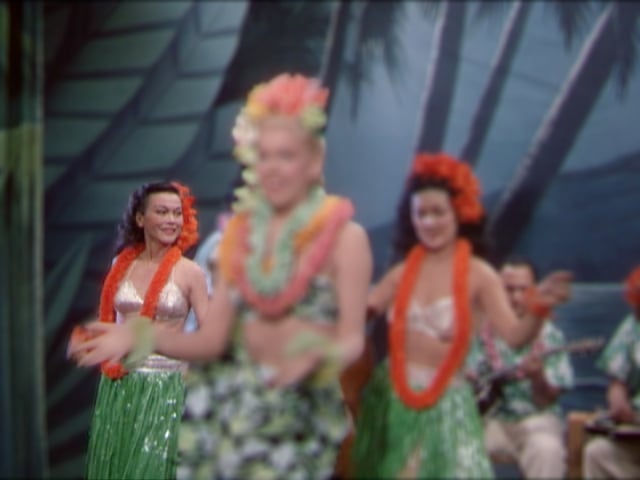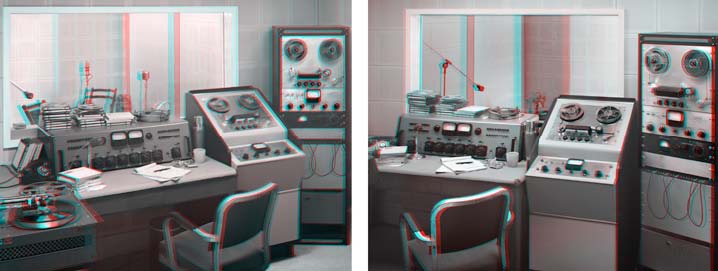Appearance of Isabel Rosario Cooper
2009 - Film & Video (Film & Video)
11:39 minutes
Miljohn Ruperto
Miljohn Ruperto’s silent video work Appearance of Isabel Rosario Cooper is an archive of ghosts. The video’s title figure, a Filipina actress, vaudeville dancer and singer who played racialized, peripheral roles in Hollywood in the 1940s and 1950s, flits in and out of a montage of scenes. Ruperto digitally modified the 16mm film by blurring the background and all of the figures in each scene except for Cooper herself. She is the only crisply delineated figure in an ocean of blurred faces and bodies, often hovering on the sidelines. She is a caretaker, a nurse, a nanny, a maid, a backup dancer, a woman in the shadows. After only a few minutes, it becomes immediately apparent that her appearances are brief and that she usually plays a peripheral character, overshadowed by white characters, particularly male leads. In 2007, Ruperto began working on a five-part project that sought to resuscitate and foreground a figure lost to the periphery of history, the actress Isabel Rosario Cooper. Born in Manila in 1914, Cooper had begun to develop her career as a dancer, singer and actress when she met U. S. General Douglas MacArthur in 1930. At the time, MacArthur was the commander of the U. S. troops in the Philippines, and she became his mistress. She was sixteen years old; he was fifty. When he returned to the U. S. five months later, he brought Cooper with him, arranging to keep her hidden in a secret residence at the Chastleton Hotel in Washington, D. C., which she supposedly was unable to leave for four years. In 1933, when a journalist threatened to break the news of their affair, MacArthur attempted to buy Cooper’s silence with $15,000 and a ticket back to the Philippines, which she did not use. Instead, she stayed in the United States, where she attempted to find film roles in Hollywood. She found no more than thirteen roles, which amounted to a total of sixteen and a half known onscreen minutes, and was largely cast in stereotyped and orientalized bit roles, such as a geisha, a Thai concubine or a Filipina nurse. She committed suicide in 1960, at the age of forty-six. Working frequently to reconfigure historical archives while investigating the circumstances through which they are constructed, Ruperto uses Appearance of Isabel Rosario Cooper to investigate the archive’s possibilities for a reworking of history and truth. The work acts as a re-contextualized actor’s reel, serving as both a memorial to a woman’s life and a glimmer of digital afterlife. It is a reminder of the existence of a woman who became both a historical and a cinematic Other, but it is also a reminder of the ways in which screen images can take on a life of their own, vehicles for visual reincarnation, rehabilitation, and resuscitation.
Miljohn Ruperto is a cross-disciplinary artist working across photography, cinema, performance, and digital animation. His work refers to historical and anecdotal occurrences, and speculates on the nature of assumed facts and the construction of truth. Often involving replicas, modified versions, and enactments—including Chinese-made reproductions of Caspar David Friedrich’s The Monk by the Sea ; modified images based on the 15th century Voynich Manuscript; or reworked footage of Filipino actress Isabel Rosario Cooper—Ruperto takes cultural and historical references and untethers them from their original context to challenge our perception and generate something altogether new. Ruperto’s work is often informed by his collaborations with experts from other disciplines including Dutch animator Aimée de Jongh, neuroscientist and engineer Rajan Bhattacharyya, photographer Ulrik Heltoft among others. Through a richness and diversity of lenses, and preferencing the obscure, mysterious and the magical, his work challenges fixed conceptions of truth and history, and instead speaks of an indeterminacy and subjectivity of experience that renders truth and fiction near indistinguishable.
Colors:
Related works featuring themes of: » Black-and-White Photography, » Contemporary Fact Versus Fiction, » Dark, » Flora, » Filipino and Danish
» see more

© » KADIST
Natasha Wheat
2011Natasha Wheat’s Kerosene Triptych (2011) is composed of three images, one each from the digital files of the Library of Congress, the Smithsonian Institution, and the Field Museum tropical research archive...

© » KADIST
Elad Lassry
2012The black-and-white photograph Men (055, 065) (2012) depicts two similarly built young men – young and slim, with dark tousled hair and a square jaw line – seated aside one another in identical outfits...

© » KADIST
Agnieszka Kurant
2022For Sentimentite Agnieszka Kurant collaborated with Justin Lane, CEO and Co-Founder of CulturePulse, to gather global sentiment data that has been harvested from millions of Twitter and Reddit posts related to 100 seismic events in recent history...
Other related works, blended automatically
» see more

© » KADIST
Miljohn Ruperto
2013Miljohn Ruperto’s high-definition video Janus takes its name from the two-faced Roman god of duality and transitions, of beginnings and endings, gates and doorways...

© » KADIST
Natasha Wheat
2011Natasha Wheat’s Kerosene Triptych (2011) is composed of three images, one each from the digital files of the Library of Congress, the Smithsonian Institution, and the Field Museum tropical research archive...
Related works sharing similar palette
» see more

© » ARTS EQUATOR
SEE WHAT SEE: BOYS' LOVE (BL) DRAMAS | ArtsEquator Thinking and Talking about Arts and Culture in Southeast Asia ArtsEquator Viewpoints November 13, 2021 By Lainie Yeoh I grew up in an era where queer films were rare exceptions and it was your holy gay-af duty to watch all the ones you could access...

© » KADIST
Clarissa Tossin
2017Clarissa Tossin’s film Ch’u Mayaa responds to Frank Lloyd Wright’s Hollyhock House (constructed 1919–21) in Los Angeles, an example of Mayan Revival architecture...
Related works from the » 2000's created around » Los Angeles, California
» see more

© » KADIST
Julio Cesar Morales
2006Julio Cesar Morales’s watercolor drawings, Undocumented Intervention , show a variety of surprising hiding places assumed by people trying to cross into the United States without documentation...

© » KADIST
Jedediah Caesar
2009For Untitled, Caesar encased recycled objects such as scraps of plywood, paper or cloth in resin and then cut and reassembled the pieces into abstract forms...

© » KADIST
Paul McCarthy
2008Memory Mistake of the Eldridge Cleaver Pants was created for the show Paul McCarthy’s Low Life Slow Life Part 1 , held at California College of the Arts’s Wattis Institute in 2008 and curated by McCarthy himself...
Other works by: » Miljohn Ruperto
» see more

© » KADIST
Miljohn Ruperto
2013Miljohn Ruperto’s high-definition video Janus takes its name from the two-faced Roman god of duality and transitions, of beginnings and endings, gates and doorways...

© » KADIST
Miljohn Ruperto
2009Acting Exercise: Demon Possession is a video by Miljohn Ruperto that addresses notions of performativity, the self, and collective truth...

© » KADIST
Miljohn Ruperto
2017Miljohn Ruperto’s research-based multidisciplinary practice often deals with possession, re-enactment, mythology and archives...
Related works found in the same semantic group
» see more

© » HYPERALLERGIC
Pauline Curnier Jardin and the Feel Good Cooperative Collaborate on “Roman Parties” Skip to content Installation shot from Roman Parties exhibition by Pauline Curnier Jardin and Feel Good Cooperative, on view at Prague City Gallery (photo by Jan Kolský) Pauline Curnier Jardin founded the Feel Good Cooperative with the help of photographer and sex worker Alexandra Lopez and architect and academic Serena Olcuire...

© » KADIST
Asli Çavusoglu
2020In the exhibition Pink as a Cabbage / Green as an Onion / Blue as an Orange , Asli Çavusoglu pursues her work on color to delve into an investigation into alternative agricultural systems and natural dyes made with fruits, vegetables, and plants cultivated by the farming initiatives she has been in touch with...







